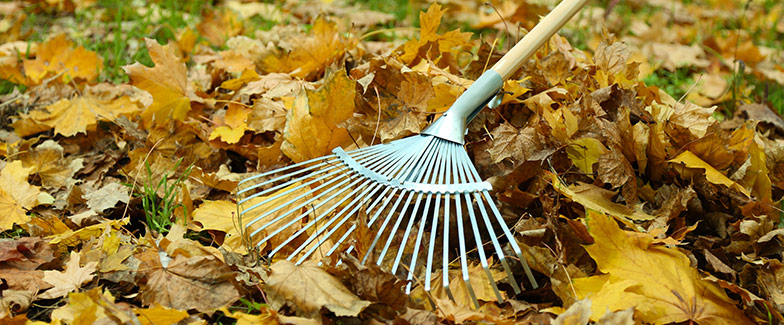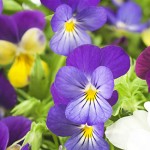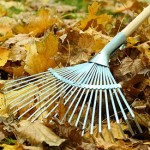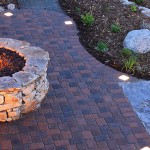
You’ve invested time and money nurturing and cultivating the perfect landscape. Now it’s time to protect that investment. Winter weather can take a toll on your landscape. With proper preventative maintenance in the fall, your landscape will be protected through the winter and come back looking better than ever in the spring.
Landscape beds
Out with the old and in with the new is a good approach to take with your landscape beds. Start out by removing all of the old plant debris. This includes removing leaves, dead foliage, and spent annuals, which can harbor disease and insects. Perennials should be cut back to within an inch or two of the soil level. You should also pull any weeds in the beds. If you leave them, not only will they come back in the spring, but they will likely come back in larger numbers.
Once you have all of the old, spent landscaping removed, it’s time to add in new plants. Fall is the time to plant your spring-blooming bulbs. Bulbs should be planted when the ground in cool, when evening temperatures are around 40 to 50 degrees. This is typically close to the time of the first frosts.
Your landscape beds are now ready for the winter. But that doesn’t mean you have to put your beds into hibernation. This is a perfect time to introduce fall colors into your landscape beds. There are a variety of annuals that you can plant to bring the warm colors of fall into your landscape. Look for hardy flowers and plants in shades of crimson, rusty orange, gold, and deep purple that thrive in colder temperatures.
The final step in preparing your landscape beds is to replenish your mulch. Adding mulch will help keep the temperature even over the winter, which will protect your plants and help retain moisture. This should be done in the late fall.
Lawn
Help your lawn survive the winter and thrive in the spring by giving it some TLC now. Start off by raking and removing all of the leaves from your lawn. Leaves left over the winter will smother your grass and allow mold and disease to develop. Freezing and thawing can also cause leaves and other organic debris left on your lawn to release soluble forms of phosphate and nitrates, which can then get into the surface water.
Fall is also a good time to get rid of the weeds in your lawn by spraying them with a selective herbicide. As with your landscape beds, weeds not dealt with now will still be there in the spring and may spread seeds, leading to even more weeds.
Next, aerate your lawn to lawn to allow water, oxygen, and fertilizer easier access to the root system. About a month before the first freeze, you should fertilize your lawn. These nutrients will help the roots survive hibernation over the winter.
While you will need to continue mowing into the fall until the grass stops growing, you need to be careful how long or short you mow it. You should keep it between 2 and 2 ½ inches long throughout the fall. Grass that is taller than 2 inches will mat, which could lead to disease problems such as snow mold. If you cut your grass shorter than 2 inches, you will limit its ability to make and store food for growth in the spring.
Trees and shrubs
Fall is the perfect time to plant new trees and shrubs. The cooler weather will allow them to become established without the stress caused by summer heat. Be sure to add a layer of mulch to help protect the newly established root system over the winter. Wrap the stems or trunks of young trees with wire or tree-guard products to protect them from animals and harsh winter winds.
Thin out large shade trees and shrubs to allow snow to fall through the branches rather than pile on them, which could cause branches to split or break. After the leaves have fallen off, inspect your trees and shrubs for any structural problems. Remove any broken or damaged limbs. Pruning during the dormant season can help prevent insect and disease damage from the new cuts.
Give your trees and shrubs a deep watering after the leaves drop, before the first freeze and before you turn off the water for the season.
Prepare any vulnerable trees and shrubs before the first freeze. Move any container plants indoors where the temperatures will stay above freezing. For plants that cannot be moved inside, cover them with plastic. Wrap shrubs in burlap to help protect them. If there is a warm spell, remove the coverings during the day and then replace them at night. For trees that are subjected to constant wind exposure, place a wood or plastic snow fence in front of them to act as a wind block.
Many salt and melting agents can be damaging to trees, shrubs, and plants. If you have plants near sidewalks or driveways, consider shoveling or using a snow blower to remove snow in these areas. If you must use a de-icing agent, consider putting up a snow fence to protect your trees and shrubs from these chemicals.
Finally, protect your trees, shrubs, and plants with a fresh layer of mulch, about 2 to 3 inches deep. Mulching in the fall is actually better for your plants than mulching in the spring. The added mulch will help protect the roots from frost, maintain an even temperature, and help retain moisture.
Sprinkler winterization
One last step in your winter preparation is to winterize your sprinkler system. It is not enough to simply shut off the system and open the drain valve. Water can still remain and freeze, causing pipes to crack or rupture. This type of damage can be very costly. To prevent damage, have a professional perform a sprinkler blow out, which will safely and properly remove all of the water from your sprinkler system. A sprinkler system blow out should be done every year before the first freeze of the season.





